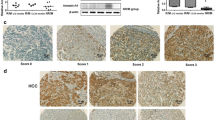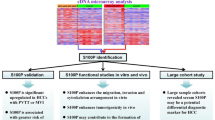Abstract Purpose:
To study the relationship between intercellular adhesion molecule 1 (ICAM-1) and liver cancer metastasis and to find predicting factors that could indicate the growth and metastasis of liver cancer. Methods: ICAM-1 expression in fresh tissue of normal liver and hepatocellular cancer (HCC) was examined by immunoperoxidase staining. Serum soluble intercellular adhesion molecule 1 (sICAM-1) from patients with a benign HCC tumor, and the expression of ICAM-1 in the orthotopically transplanted LCI-D20 tumor of a nude mouse liver cancer metastasis model, and in human hepatoma, the tumor surrounding tissue and normal liver, was analyzed semiquantitatively by the immuno-dot blot method. Tissue ICAM-1 expression (mRNA level) was detected by Northern blotting. Results: ICAM-1 expression in LD1-20 D metastatic liver cancer had a positive correlation with tumor size and the time after implantation. It increased suddenly as metastasis occurred being 3.03 ± 0.51 before metastasis and 8.24 ± 0.95 after metastasis, P < 0.01, then remained high, appending on the number of sites involved (monosite metastasis 5.48 ± 0.49, multisite metastasis 10.05 ± 1.17, P < 0.05). All six cases of normal liver samples were negative in anti-ICAM-1 immunohistochemical staining, 80.0% (36/45) of the HCC showed some ICAM-1 expression. The rate of positive cells was a little higher in large tumors, tumors with an intact capsule and tumors with metastasis, but there was no significant difference. It was noticed that two cancer emboli also had high ICAM-1 expression. The ICAM-1 concentration in HCC (13.43 ± 0.09) was higher than that in tumor surrounding the liver (5.89 ± 0.17, P < 0.01) and that in normal liver (4.27 ± 0.21, P < 0.01). sICAM-1, like tissue ICAM-1, was higher in HCC patients than in patients (with benign liver tumor and normal controls. Both tissue ICAM-1 and sICAM-1 were higher in the metastasis group than in the group without metastasis (tissue ICAM-1 20.24 ± 0.30 vs 10.23 ± 0.12 P < 0.05; sICAM-1 12.18 ± 0.25 vs 9.77 ± 0.54 P < 0.05). Northern blot analysis revealed that ICAM-1 expression, as indicated by mRNA level, was also higher in HCC and in cancer emboli than in tumor surrounding liver and normal liver. Conclusions: Tissue ICAM-1 and serum sICAM-1 could indicate the stage of HCC, and the potential of hepatoma cells for invasion and metastasis. They may play an important role in the metastasis cascade.
Similar content being viewed by others
Author information
Authors and Affiliations
Additional information
Received: 20 January 1998 / Accepted: 25 June 1998
Rights and permissions
About this article
Cite this article
Sun, JJ., Zhou, XD., Liu, YK. et al. Invasion and metastasis of liver cancer: expression of intercellular adhesion molecule 1. J Cancer Res Clin Oncol 125, 28–34 (1999). https://doi.org/10.1007/s004320050238
Issue Date:
DOI: https://doi.org/10.1007/s004320050238




